
HMS Penelope was a Leander-class frigate of the Royal Navy. Like other ships of the class, Penelope was named after a figure of mythology. She was launched on 17 August 1962 and commissioned on 31 October 1963. Penelope had originally been intended to be part of the Salisbury class and was to have been named Coventry (and before that Panther), but instead became part of the Leander class.
Upon commissioning, Penelope joined the 20th Frigate Squadron which was based in the United Kingdom. In 1966 Penelope underwent a refit that re-roled her into a trials ship and led to the removal of much of her weaponry, including her twin 4.5-in gun turret.
In 1968, Penelope assisted in the aftermath of the Aer Lingus Flight 712 crash in the Irish Sea. There has been a number of conspiracy theories about the crash, including the alleged involvement of Penelope. The theory goes that the ship, while performing tests, mistook the aircraft for a target drone and shot her down. It is difficult to apply any credence to this theory when considering the physical size of the aircraft, the flight profile, height and speed at which it was flying (beyond the stated engagement range of a Seacat system), and the fact that at this time HMS Penelope was a trials ship, not a front-line unit, and therefore unlikely to have had any 'war-load' Seacat missiles aboard at the time, only practice or dummy rounds. All conspiracy theories have been refuted by the Ministry of Defence.
The following year, Penelope was present in West Germany during the Kiel Week festival which combined a yachting race and festival events. She took part in a variety of tests in the 1970s, including those on her Sea Wolf missile in 1977. In 1981, she was fitted with the Exocet missile with the intention of testing it.
In 1982, Penelope took part in the Falklands War as part of the "Bristol group", which included two other Leander-class ships - Minerva and Andromeda - Upon her arrival, Penelope mainly performed escort duties, including escorting the damagedArgonaut in late May, who had suffered damage after being hit by cannon fire and bombs.
On 13 June, Penelope's Lynx helicopter struck the already stranded Argentinian patrol boat Rio Iguazu with a Sea Skua missile. Penelope returned home in September 1982.
Soon after, Penelope undertook a Falklands patrol in the tense aftermath of the war, and did not return home until June 1983. The following year, she deployed to the South Atlantic again, patrolling and performing other duties in that region.
In 1988 the ship suffered a machinery breakdown and collided with the starboard side of the Canadian Naval supply ship HMCS Preserver (AOR 510) during a replenishment. Penelope caught the Preserver's starboard anchor, cutting her port side open.
The Canadian vessel suffered $260,000 damage, while Penelope suffered damage estimated in the millions.
The ninth Penelope (F127) was launched in 1962 and sold to Ecuador in 1991,
which operated her as Presidente Eloy Alfaro.

HMCS PERSERVER (A0R 510) and HMS PENELOPE (F127) collide near Vestfjorden, Norway on 11 September 1988. HMS PENELOPE (F127) was approaching HMCS PERSERVER (A0R 510) for a RAS when she had a steering failure.
HMS PENELOPE (F127) caught HMCS PERSERVER’S (A0R 510) starboard anchor, cutting her port side open.
HMS Penelope F127 Ship Photo's 1963 - 1991
If you click on a photo it enlarge all photo's in the gallery you can then scroll to view each photo.
Click on X top right corner will then close gallery and return you to website
Did you Serve on HMS Penelope
between 1963 -1991, but can't see yourself in our gallery? Go to contact page and let us know!
Send in your phots or videos and we will upload them to this site
 |  |
|---|---|
 |  |
 |  |
 |  |
 |  |
 |  |
 | 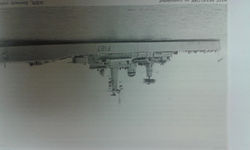 |
 |  |
 |  |
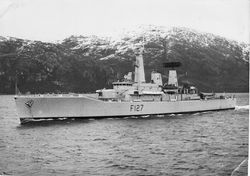 |  |
 |  |
 |  |
 |  |
 |  |
 |  |
 |  |
 |  |
 |  |
 |  |
 |  |
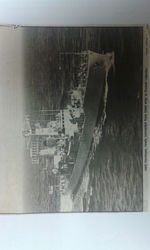 |  |
 |  |
 |  |
 |  |
 |  |
 |  |
 |  |
 |  |
 |  |
 |  |
 |  |
 | 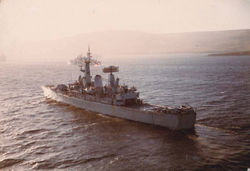 |
 |  |
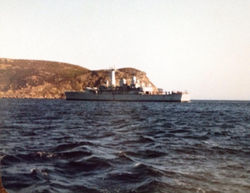 |  |
 |  |
 |  |
 | 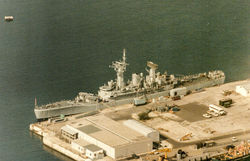 |
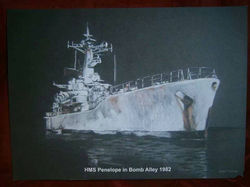 |  |
 |  |
 |  |
 |  |
 |  |
 |  |
 | 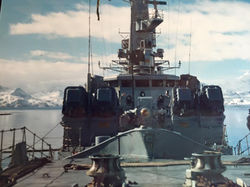 |
 |  |
 |  |
 |  |
 |  |
 |  |
 |  |
 |  |
 |  |
 |  |
 |  |
 |  |
 |  |
 |  |
 |  |
 |
Ship's company 1963 -1991
 |  |
|---|---|
 |  |
 |  |
 |  |
 |  |
 |  |
 |  |
 |  |
 |  |
 |  |
 |  |
 | 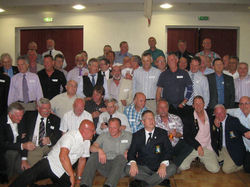 |
 |  |
 |  |
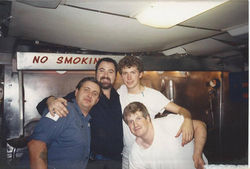 |  |
 |  |
 |  |
 |  |
 |  |
 |  |
 |  |
 |  |
 |  |
 |  |
 |  |
 |  |
 |  |
 |  |
 |  |
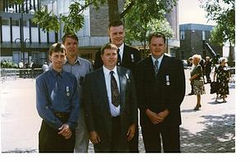 |  |
 | ![553896_255335637903278_1306009593_n[1]](https://static.wixstatic.com/media/73c60a_a1c7f4a3e8f04126bc9cd4dac4e39b19.jpg/v1/fill/w_250,h_166,al_c,q_90,enc_auto/73c60a_a1c7f4a3e8f04126bc9cd4dac4e39b19.jpg) |
![540543_10150870197232686_203813481_n[1]](https://static.wixstatic.com/media/73c60a_3d9b8b69025f4b8195d9781e3b5ba106.jpg/v1/fill/w_250,h_190,al_c,q_90,enc_auto/73c60a_3d9b8b69025f4b8195d9781e3b5ba106.jpg) | ![579958_10151232830729575_105856404_n[1]](https://static.wixstatic.com/media/73c60a_33932114ddaa4583ae2a4486de5e20f4.jpg/v1/fill/w_250,h_181,al_c,q_90,enc_auto/73c60a_33932114ddaa4583ae2a4486de5e20f4.jpg) |
![536338_10150959813224185_1164873322_n[1]](https://static.wixstatic.com/media/73c60a_a3a32be579cf4596859f2e5d59b039f8.jpg/v1/fill/w_250,h_172,al_c,q_90,enc_auto/73c60a_a3a32be579cf4596859f2e5d59b039f8.jpg) |  |
![554679_139814572827798_287877119_n[1]](https://static.wixstatic.com/media/73c60a_e7c6eb2f7dc846e5af346f59b88f928b.jpg/v1/fill/w_250,h_187,al_c,q_90,enc_auto/73c60a_e7c6eb2f7dc846e5af346f59b88f928b.jpg) | ![560307_101488399993749_2095054221_n[1]](https://static.wixstatic.com/media/73c60a_2d1597b18094412f8d66b7e901b74066.jpg/v1/fill/w_250,h_187,al_c,q_90,enc_auto/73c60a_2d1597b18094412f8d66b7e901b74066.jpg) |
![549711_4629978834457_1310319329_n[1]](https://static.wixstatic.com/media/73c60a_3f134b96e53d4b54abd4137721f0ae5e.jpg/v1/fill/w_250,h_209,al_c,q_90,enc_auto/73c60a_3f134b96e53d4b54abd4137721f0ae5e.jpg) | ![556571_4500792047609_1847595656_n[1]](https://static.wixstatic.com/media/73c60a_c0a36ee4521e41a0a67b25629b6c4c45.jpg/v1/fill/w_250,h_192,al_c,q_90,enc_auto/73c60a_c0a36ee4521e41a0a67b25629b6c4c45.jpg) |
![580039_2865187327083_1935465239_n[1]](https://static.wixstatic.com/media/73c60a_b93ca746b03c46c1aea14d1aaaa73456.jpg/v1/fill/w_250,h_165,al_c,q_90,enc_auto/73c60a_b93ca746b03c46c1aea14d1aaaa73456.jpg) | ![535670_3898562348016_331986991_n[1]](https://static.wixstatic.com/media/73c60a_c0e55ad1b0df4b8291a7fd3239862c51.jpg/v1/fill/w_250,h_200,al_c,q_90,enc_auto/73c60a_c0e55ad1b0df4b8291a7fd3239862c51.jpg) |
![532874_10150735180936307_2055700022_n[1]](https://static.wixstatic.com/media/73c60a_2e8fdf726c3941a3ac91d66cc59d1a52.jpg/v1/fill/w_250,h_186,al_c,q_90,enc_auto/73c60a_2e8fdf726c3941a3ac91d66cc59d1a52.jpg) |  |
 |  |
 |  |
 |  |
 |  |
![205835_139814699494452_1539875533_n[1]](https://static.wixstatic.com/media/73c60a_6f172d28449e483c965c12b075702da3.jpg/v1/fill/w_250,h_187,al_c,q_90,enc_auto/73c60a_6f172d28449e483c965c12b075702da3.jpg) | ![179477_230161770420665_1826556633_n[1]](https://static.wixstatic.com/media/73c60a_fd18e8740d634b73aa8d8bfe1da26ed1.jpg/v1/fill/w_250,h_322,al_c,q_90,enc_auto/73c60a_fd18e8740d634b73aa8d8bfe1da26ed1.jpg) |
![252735_10150975610894185_1983033383_n[1]](https://static.wixstatic.com/media/73c60a_e63a0cbbc46741faa11423682e13c166.jpg/v1/fill/w_250,h_341,al_c,q_90,enc_auto/73c60a_e63a0cbbc46741faa11423682e13c166.jpg) | ![303506_230161870420655_965041605_n[1]](https://static.wixstatic.com/media/73c60a_60de65a9aa0f48f9a3fce978839f1080.jpg/v1/fill/w_250,h_198,al_c,q_90,enc_auto/73c60a_60de65a9aa0f48f9a3fce978839f1080.jpg) |
![223916_139815166161072_714905288_n[1]](https://static.wixstatic.com/media/73c60a_12f343771c00466eacf25af787100ee5.jpg/v1/fill/w_250,h_187,al_c,q_90,enc_auto/73c60a_12f343771c00466eacf25af787100ee5.jpg) |  |
 | 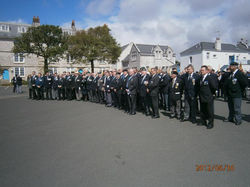 |
![384371_2200083179302_234904000_n[1]](https://static.wixstatic.com/media/73c60a_fb2a97de98e443ffbfc4f0be9e54a450.jpg/v1/fill/w_250,h_187,al_c,q_90,enc_auto/73c60a_fb2a97de98e443ffbfc4f0be9e54a450.jpg) |  |
 |  |
 |  |
 |

Penelope's third Anchor
CO Peter Rickard RN
PENELOPE had moved overnight on 19/20 June 1982 from San Carlos Water to Port William anchoring 09:00 on 20 June 1982.
However it soon became clear that due to worsening weather conditions, the selected anchorage was unsuitable and I made the decision to move the Ship to a hoped for better protected anchorage.
In weighing anchor we encountered difficulty, our anchor becoming fouled and with some surprise we then brought to the surface a very old anchor, at the time rather than lose such the relic by leaving it where we found it, but with no means of quickly getting it ashore, I "hung it" as a temporary measure on our bow until such time as we could land it at Stanley.
The anchor was relowered from the PENELOPE to the seabed with a marker and lifting strop.
As this was so soon after the war, matters to land the anchor were some what
delayed and we had to call on the help of the barge used to collect the rubbish
daily from the ships in Port William and also obtained the services of a repair
ship which had a crane on the relic was then safely placed on the "gash Barge"
Second from the right, Lieutenant Commander John Eldridge RN, the First Lieutenant HMS Penelope and myself inspect the relic once it was on the barge.
I would like to mention the good work by the buffer & FX party in their involvement in Penelope's third anchor.
Thus by the time PENELOPE sailed on the 23rd June the old anchor had been sent ashore but nothing further was heard as to its history or where it ended up.
PENELOPE was somewhat busy thereafter around the Islands and only returned to her home port Devonport in September 1982.
Having never been able to follow up where the "third anchor" ended up it was a very great pleasure to see that it has been well sited in such a prominent position outside the Museum in Stanley




